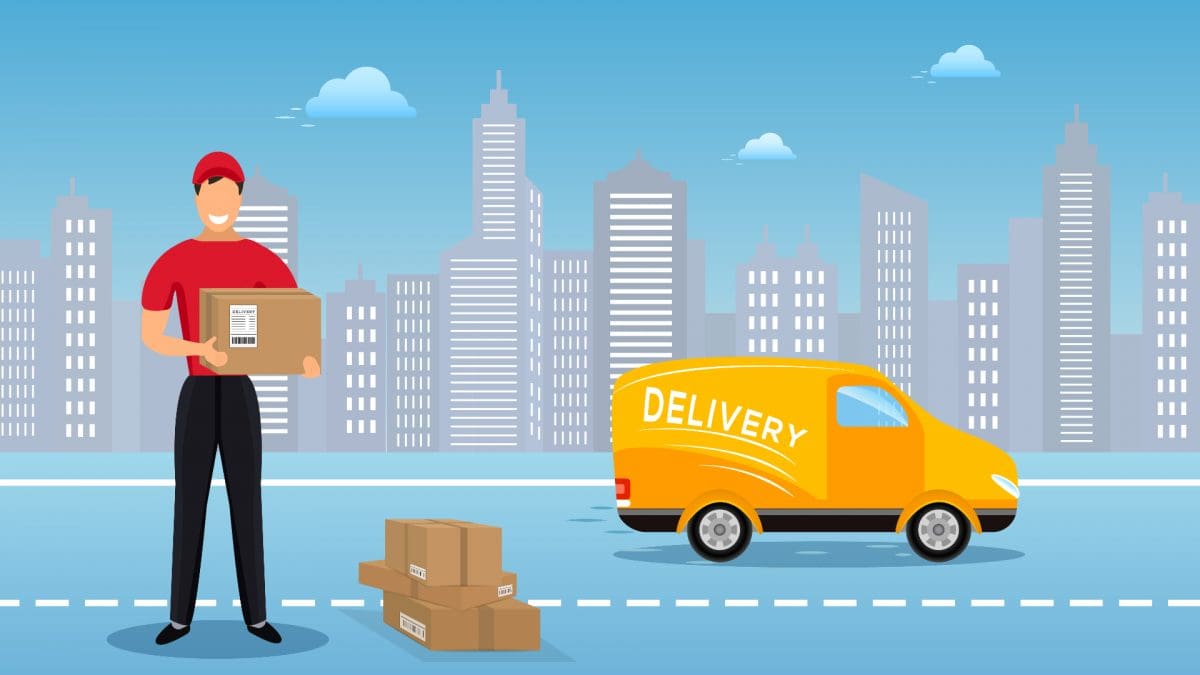
Hyperlocal delivery refers to the ability to fulfill an order within a very small radius—typically 5 to 10 miles—and at blazing speed. It connects businesses to customers within the same community, enabling deliveries within minutes or hours instead of days.
While traditional delivery links businesses to customers across large geographic areas, hyperlocal delivery focuses on fixed, small neighborhoods and towns. It has revolutionized the last mile for many industries. Grocery stores, restaurants, pharmacies, general retailers, and niche service providers can all benefit from hyperlocal delivery.
Explore this article’s key sections quickly using the table of contents below.
- How Hyperlocal Delivery Works
- Unique Benefits of Hyperlocal Delivery
- Software Systems for Hyperlocal Delivery
- Implementing Hyperlocal Delivery
- Common Hyperlocal Delivery Challenges & Solutions
How Hyperlocal Delivery Works: The Behind-the-Scenes Structure of Getting Delivery
The Core Delivery Model
Hyperlocal delivery operates through a streamlined, technology-driven process:
- Hyperlocal Ordering: Customers within the delivery area place orders from home, typically via an app or website.
- Smart Assignment: An algorithm assigns the order to the nearest available courier, factoring in distance, traffic patterns, and courier availability.
- Route Efficiency: Artificial intelligence determines the most efficient delivery route, minimizing time and fuel consumption.
- GPS Enablement: Businesses and customers use GPS to track orders in real time.
- Fast Delivery: Orders are delivered within the specified time frame—usually between 30 minutes and 2 hours of placement.
This model works because it excludes many standard logistics components, focusing solely on last-mile delivery for short-distance orders in densely populated areas.
Who Are The Stakeholders in the Hyperlocal Delivery Model?
Several key stakeholders make hyperlocal delivery possible:
- Local Businesses: Retailers, restaurants, and service providers looking to expand their customer base without building their own delivery infrastructure.
- Tech Platforms: Companies that create the digital connections between businesses, consumers, and couriers.
- Couriers: Gig workers or in-house staff who deliver items using bicycles, scooters, or cars.
- End Users: Consumers who value convenience and instant gratification.
Each stakeholder plays a vital role in this mutually beneficial system, fostering growth and success across the board.
Benefits of Hyperlocal Delivery from Different Perspectives
Advantages for Businesses
Businesses that adopt hyperlocal delivery strategies enjoy several benefits:
- Increased Order Volume: Many businesses see a rise in order volume within the first three months of implementation.
- Better Customer Retention: Hyperlocal delivery encourages repeat purchases; customers who use it tend to re-shop more than those who only shop in-store.
- Unique Selling Proposition: In markets where competitors haven’t adopted hyperlocal delivery, offering it becomes a strong differentiator.
- No Storefront Strain: Businesses can serve more customers without needing additional physical locations.
- Valuable Data: Delivery systems provide insights into customer preferences, buying habits, and peak shopping times.
For small to medium-sized businesses, hyperlocal delivery isn’t just a convenience—it’s a strategic necessity for growth.
Benefits for Consumers
Consumers also gain significant advantages from hyperlocal delivery:
- Maximum Convenience: Items are delivered without the need to visit a store, saving time and effort.
- Expanded Options: Consumers can shop from multiple local merchants without traveling between stores.
- Transparency: GPS tracking provides real-time updates on delivery status.
- Support for Local Economies: Hyperlocal delivery allows consumers to shop locally while enjoying the convenience of delivery.
- Reduced Environmental Impact: Shorter delivery distances result in lower emissions compared to traditional delivery models.
It’s no surprise that consumers are increasingly adopting hyperlocal delivery. Recent reports show that time savings are the primary reason for its popularity.

Hyperlocal Delivery Software Systems
Advanced software systems are the backbone of efficient hyperlocal delivery operations:
- Route Optimization Algorithms: AI-powered tools determine the most efficient paths, factoring in traffic, weather, and courier availability.
- Delivery Partner Apps: Mobile apps guide couriers from pickup to drop-off with turn-by-turn directions and order details.
- Customer-Facing Interfaces: User-friendly apps and websites allow customers to place orders, make payments, and track deliveries.
- Analytics Dashboards: Business intelligence platforms provide insights into operational performance, customer behavior, and revenue trends.
The best hyperlocal delivery software integrates these components into a cohesive system, ensuring seamless communication across all channels.
Implementing Hyperlocal Delivery: Strategies for Success
Assessing Delivery Capabilities
Before adopting hyperlocal delivery, companies must evaluate their ability to support such operations:
- Location Evaluation: Determine whether the business is located in a densely populated area that can sustain hyperlocal delivery.
- Product Suitability: Assess whether products are easily shippable, considering dimensions, fragility, temperature sensitivity, etc.
- Current Fulfillment Capacity: Review existing capacity to handle increased order volume and shipping demands.
- Staffing Needs: Evaluate whether additional personnel are needed for packing and managing shipments.
- Technology Systems: Identify current technological capabilities and any gaps that need to be addressed.
This assessment helps businesses anticipate challenges and develop solutions before launching hyperlocal delivery services.
Building vs. Partnering Decisions
Companies have several options when implementing hyperlocal delivery:
- Integrating with Existing Services: Partnering with established shipping providers offers immediate reach but may result in higher per-shipment costs and less control over branding and customer experience.
- Developing In-House Delivery Services: Building a proprietary delivery system provides full control and potential long-term savings but requires significant upfront investment and operational expertise.
- Hybrid Models: Outsourcing some logistics while managing others in-house allows flexibility. Many companies begin with third-party platforms and transition to hybrid models as order volume increases.
A survey of retail companies found that half started with third-party platforms and moved to hybrid models within 18 months to reduce costs and gain more control.
Typical Standards of Operation
Successful hyperlocal delivery operations follow key standards:
- Service Area: Clearly defined delivery zones with expectations for fulfillment.
- Clear Expectations: Transparent guidelines for delivery timeframes, costs, minimum order requirements, and other policies.
- Delivery Quality Guarantees: Assurance that items will arrive in proper condition, with standards for packaging and handling.
- Containment Protocols: Contingency plans for disruptions such as weather events, accidents, or demand surges.
- Metrics Monitoring: Continuous tracking of performance indicators, including delivery times, breakdowns, and customer feedback.
- Feedback Loop: A structured system for collecting and applying feedback from customers and delivery personnel to improve service.
These standards help prevent missteps and ensure a consistent, high-quality customer experience.
Solutions to Common Hyperlocal Delivery Challenges
Understanding Density and Distance
Challenge: In less densely populated areas, couriers may travel longer distances for fewer deliveries, reducing efficiency and increasing costs.
Solutions:
- Implement dynamic delivery ranges based on real-time demand and supply.
- Use order batching to group deliveries along similar routes.
- Offer customer incentives for selecting delivery windows that improve operational efficiency.
- Establish micro-fulfillment centers to reduce average delivery distances.
These strategies help maintain efficiency even in areas with lower population density.
Peak Demand Management
Challenge: Demand fluctuates throughout the day and week, creating operational strain during peak periods.
Solutions:
- Use surge pricing to manage demand.
- Apply predictive analytics to allocate resources proactively.
- Allow customers to reserve high-demand delivery windows.
- Maintain a network of backup delivery drivers to scale capacity as needed.
- Send automated goodwill messages to customers during unexpected delays.
Companies that maintain service quality during peak periods can maximize revenue and customer satisfaction.
Cost Containment Measures
Challenge: Delivery costs—including courier compensation, technology fees, and packaging—can quickly add up.
Solutions:
- Use routing software to improve efficiency and reduce fuel costs.
- Explore co-delivery models to share delivery assets between businesses.
- Invest in automation to lower labor costs per order.
- Analyze delivery expenses in detail to identify savings opportunities.
Effective cost control ensures hyperlocal delivery remains profitable for businesses and affordable for consumers.
Want more industry insights?
Subscribe to our newsletter to receive weekly last mile logistics insights directly to your email inbox each week!
Use Cases for Hyperlocal Delivery by Industry
Grocery and Food Delivery
Food delivery was the original hyperlocal use case—and remains a leader:
- Ultra-Fresh Produce: Farm-to-table delivery within hours of harvest.
- Meal Deliveries: Regular delivery of meal kits or ready-to-eat meals.
- Restaurant Aggregators: Platforms that allow ordering from multiple restaurants.
- Specialized Food Services: Providers focused on organic, multicultural, or dietary-specific meals.
Recent research shows nearly half of U.S. consumers use hyperlocal grocery delivery at least twice a month.
Retail and E-Commerce
Retailers are increasingly adopting hyperlocal strategies:
- Store-Based Fulfillment: Using physical stores as micro-fulfillment centers.
- Quick Commerce: Rapid delivery of high-demand items, often within 15–30 minutes.
- Omnichannel Fulfillment: Online orders fulfilled from local inventory for fast delivery.
- Returns Management: Convenient drop-off options for returns without visiting the store.
Retailers implementing hyperlocal delivery have seen moderate increases in online conversion rates and decreases in cart abandonment.
Wellness and Healthcare
The health and wellness industry presents unique opportunities and challenges for hyperlocal delivery, including:
- Prescription Medication Delivery: Ensuring compliance, safety, and health through hyperlocal delivery of medications.
- Critical Medication and Medical Supply Delivery: Delivering essential items directly to patients’ homes, doctors’ offices, and nursing homes.
- Blood Sample Transport: Moving bloodwork and lab samples to and from testing facilities.
- Aging Population Services: Providing deliveries for individuals who may have mobility challenges—whether it’s mobility aids or essential items.
These are just a few examples of how hyperlocal delivery goes beyond convenience and helps address gaps in healthcare access. One survey found that 28% of people filled prescriptions when delivery was available.
The Future of the Hyperlocal Delivery Industry
Green Initiatives
With sustainability becoming a top priority, several eco-friendly solutions are emerging:
- Electric Vehicles: Transitioning from gas-powered vehicles to e-bikes and electric vans for daily deliveries.
- Reduced Packaging: Using minimal or reusable, recyclable, and biodegradable packaging for short-distance deliveries.
- Carbon-Neutral Delivery: Implementing protocols to offset the carbon footprint associated with delivery operations.
Evolving Business Models
The hyperlocal delivery landscape continues to evolve through innovative business models:
- Subscription-Based Delivery: Merchants offering unlimited deliveries for an annual fee.
- Curated Deliveries: Bundling items from neighborhood brands to encourage impulse purchases.
- Micro-Warehousing: Leasing space in residential buildings to serve as small-scale distribution centers.
- Peer-Sharing Fulfillment: Leveraging customers of other merchants to fulfill and deliver local merchandise.
- Online-to-Offline Transactions: Using online platforms to facilitate offline purchases, enhanced by hyperlocal delivery.
- Microentrepreneur Platforms: Empowering small businesses with delivery capabilities previously reserved for larger enterprises.
- Vertical Delivery Companies: Specializing in delivery for specific industry sectors with high demand and logistical needs.
The Strategic Imperative of Hyperlocal Delivery
Hyperlocal delivery is no longer a novelty—it’s a necessity. As consumers demand faster, more affordable service, businesses that can deliver products within hours gain a significant competitive edge.
For companies exploring hyperlocal delivery, success depends on:
- Strategic technology partnerships
- Clear communication and feedback channels
- Continuous operational assessments and optimization
While profitability and logistics remain challenges, the potential for new revenue streams, improved customer retention, and enhanced competitiveness makes hyperlocal delivery worth considering.
Interested in hyperlocal delivery for your business? Contact Elite EXTRA today to learn how you can leverage our Delivery Network for your delivery needs.







